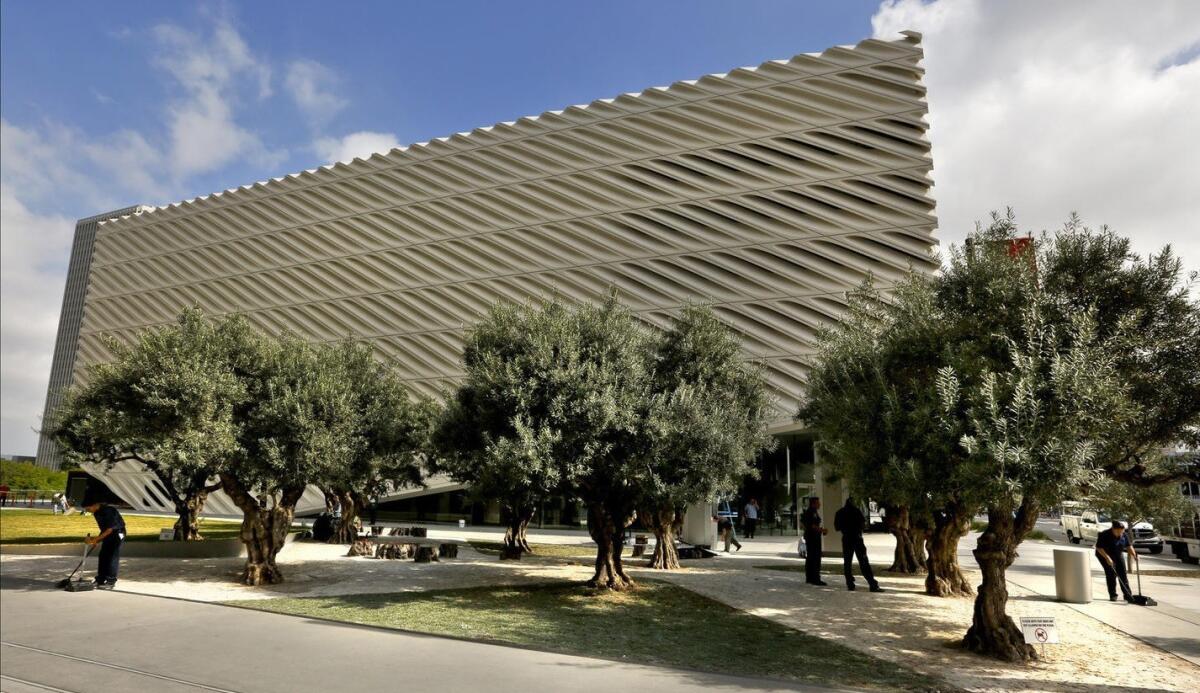Why you need to check out Broad Plaza, an inviting outdoor space in the new museum’s shadow

The urban landscape of the new Broad Plaza, the public space associated with downtown’s newest museum, is more organic, flirting with civic engagement, simplicity and the shared space that exists between apartment dwellers, museum-goers and, yes, lunchtime visitors.
- Share via
Some urban landscapes feel like temporary spaces designed to accommodate office workers on their lunch break. Others, such as the new Broad Plaza, the public space associated with downtown’s newest museum, are more organic, flirting with civic engagement, simplicity and the shared space that exists between apartment dwellers, museum-goers and, yes, lunchtime visitors.
New York architectural firm Diller Scofidio + Renfro and designer Walter Hood of Oakland-based Hood Design Studio say the driving force behind the 24,000-square-foot plaza adjacent to the newly opened Broad museum was simply to create an environment that would bring people in from the street.
------------
FOR THE RECORD
An earlier version of this post identified Walter Hood as a landscape architect. He is an artist and designer.
-----------
“Our thinking was, ‘Why would anyone choose this plaza?” says lead architect Elizabeth Diller. “There has to be a reason for them to congregate here.”
From the beginning, the plaza was envisioned as a public space for picnics, outdoor movies, performances and educational events. Otium, a new restaurant under construction at the rear of the space, will eventually be a part of the elevated park, creating an indoor-outdoor environment.
Just as the exterior concrete “veil” of the Broad museum counters the shiny exterior of Walt Disney Concert Hall next door, the outdoor plaza goes a step further in its spareness, offering simple patches of materials and experiences — decomposed gravel, dymondia, a soft lawn and a fairy-tale-like grove of 100-year-old Barouni olive trees — to lure you in from the street.
Where the Broad is modern and new, the olive trees are gnarled and ancient. “They have character,” says Hood. “They are like the grandparents. They’ve been through it all.”
The slow-growing, drought-tolerant trees create a low canopy of shade and offer a striking contrast to the exterior of the museum. Underneath that canopy, visitors will immediately notice a group of low seats composed of repurposed tree trunks from the same nursery as the olive trees.
The simple formula of trees, shadow and light is one Hood describes as “symbolic of Los Angeles.”
But what about the lawn? How could they install grass in the middle of a severe drought?
“There has to be a reason for people to congregate here,” says Diller, who also designed the hugely popular High Line public park in New York. “When we initially thought about the plaza in 2011, we thought about how it would draw people in, rather than simply being nice and green. We wanted a soft surface where people can sit. The soft space is what brings people in.”
In addition, the lawn is small scale — less than one-quarter of the long, linear plaza — and is designed to recover rainwater courtesy of a sump pump behind the restaurant.
The plaza feels peaceful and tended, but the landscaping does not stop there. In an effort to connect the cultural institutions on Bunker Hill — the Colburn School, the Museum of Contemporary Art, Disney Hall, REDCAT, the Music Center — the architects extended the landscape beyond the plaza. At 2nd Street, younger olive trees are planted in a Grand Avenue median that intersects a new crosswalk designed to create visual access from one side of Grand to the other.
Sedum-filled planters the architects call “eruptions” are placed along the Grand Avenue sidewalk in front of the museum, offering an interesting juxtaposition to the large exterior grill of the structure. “They are beautiful, sculptural things,” says Hood. “A little like the dreads on my head,” he adds with a laugh.
A soft lawn. Time-worn olive trees. Sedums bursting from the sidewalk. These are straightforward elements that Hood believes can transform mundane things like a sidewalk or a crosswalk into something more. “Each one of these things has its own rigor. We’re trying to introduce a new way of looking at the urban landscape.”
Indeed, there is limited formal seating and no fuss. The point, it seems, is to come and stay.
Twitter: @lisaboone19
::
Broad museum inaugural exhibition info
What: Contemporary works by more than 60 artists
Where: 221 S. Grand Ave., Los Angeles
When: 11 a.m. to 5 p.m. Tuesdays and Wednesdays, 11 a.m. to 8 p.m. Thursdays and Fridays, 10 a.m. to 8 p.m. Saturdays, 10 a.m. to 6 p.m. Sundays. Closed Mondays (the plaza is always open).
Admission: Free, but reservations are required and can be made online at www.thebroad.org/tickets or at the museum ticket counter.
Info: (213) 232-6200; www.thebroad.org
ALSO:
Inspiration -- and tips -- for drought gardening
It’s Dry Out There: 11 Inspiring water-wise landscapes
Will L.A. become the land of front-yard veggie gardens? This couple is leading the way
More to Read
The biggest entertainment stories
Get our big stories about Hollywood, film, television, music, arts, culture and more right in your inbox as soon as they publish.
You may occasionally receive promotional content from the Los Angeles Times.











